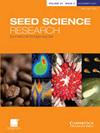种皮厚度解释了亮子树对烟和热的不同萌发反应
IF 1.9
3区 生物学
Q2 PLANT SCIENCES
引用次数: 0
摘要
火灾刺激了易发生火灾的植被中大多数种子的发芽。蛋白质科(Proteae)的果实是有翼的瘦果或小坚果,与它们在促进发芽过程中对烟雾和/或热量的需求有关。我们描述了植物中五种可能的烟热休眠释放/发芽综合征,其中Leucadedron表现出三种(无反应、仅烟、烟和热)。由于种皮厚度随种子储存位置(植物或土壤)和形态(有翼或无翼)而变化,我们测试了其在吸水和发芽中的可能作用。有翼种子的物种在没有烟雾/热量的情况下实现了100%的发芽,种皮薄了一个数量级,其渗透性大大超过了小坚果。随着种皮厚度的增加,(1)吸收水分以下降的速度下降,(2)对烟雾和热量的反应呈线性增加,达到接近有翅种子的发芽水平。对于对烟雾和热量有反应的物种,当它们一起使用时没有相加效应,这表明它们可能促进了相同的生理过程。我们得出的结论是,种皮厚度是该属种子发芽要求的关键,与种子储存位置或形态无关。通过什么机制(1)种皮越厚,烟雾反应越大;(2)烟雾化学物质可能会增加透水性,以解释烟雾和热量的非相加效应,值得进一步研究。本文章由计算机程序翻译,如有差异,请以英文原文为准。
Seed-coat thickness explains contrasting germination responses to smoke and heat in Leucadendron
Fire stimulates the germination of most seeds in fire-prone vegetation. Fruits of Leucadendron (Proteaceae) are winged achenes or nutlets that correlate with their requirements for smoke and/or heat in promoting germination. We describe five possible smoke–heat dormancy-release/germination syndromes among plants, of which Leucadendron displays three (no response, smoke only, smoke and heat). As seed-coat thickness varies with seed-storage location (plant or soil) and morphology (winged or wingless), we tested its possible role in water uptake and germination. Species with winged seeds achieved 100% germination in the absence of smoke/heat, seed coats were an order of magnitude thinner, and their permeability greatly exceeded that of nutlets. As seed-coat thickness increased (1) imbibitional water uptake declined at a decreasing rate, and (2) the response to smoke, and to a lesser extent heat, increased linearly to reach levels of germination approaching those of winged seeds. For species responsive to smoke and heat, there was no additive effect when applied together, suggesting that they may have promoted the same physiological process. We conclude that seed-coat thickness holds the key to germination requirements in this genus, independent of seed-storage location or morphology. By what mechanisms (1) the smoke response is greater the thicker the seed coat and (2) smoke chemicals might increase water permeability to explain the non-additive effect of smoke and heat, warrant further investigation.
求助全文
通过发布文献求助,成功后即可免费获取论文全文。
去求助
来源期刊

Seed Science Research
生物-植物科学
CiteScore
3.60
自引率
4.80%
发文量
23
审稿时长
>12 weeks
期刊介绍:
Seed Science Research, the official journal of the International Society for Seed Science, is a leading international journal featuring high-quality original papers and review articles on the fundamental aspects of seed science, reviewed by internationally distinguished editors. The emphasis is on the physiology, biochemistry, molecular biology and ecology of seeds.
 求助内容:
求助内容: 应助结果提醒方式:
应助结果提醒方式:


